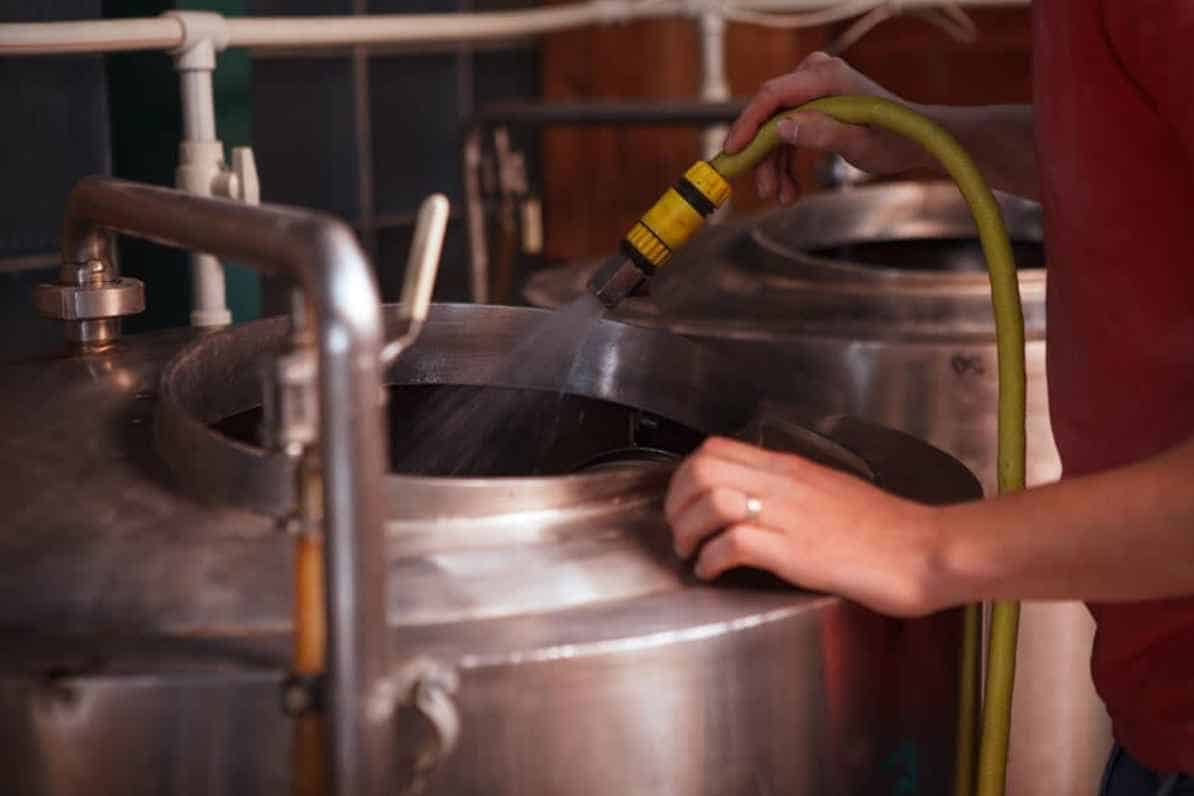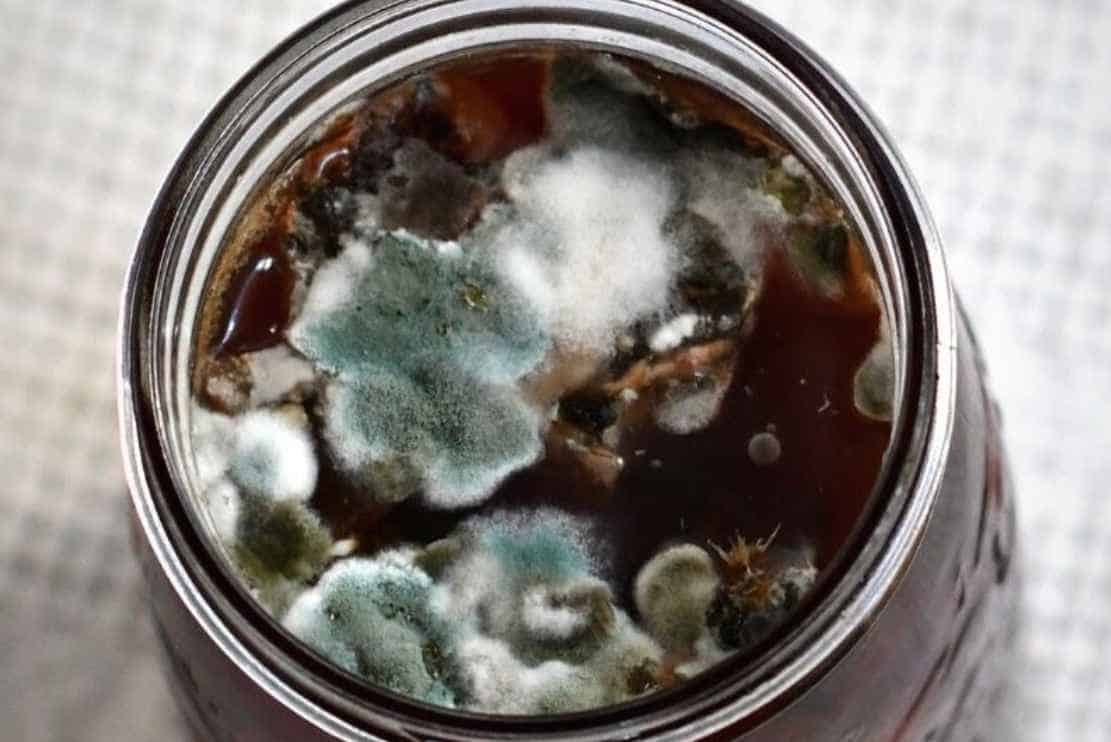Mold is a substance formed from a fungal growth. Fungi prey on highly nutritious foods, and beer is no different. Beer mold manifests as a fuzzy patch floating on the surface. Beer mold is one among many challenges that homebrewers face.
A mold infestation can force you to dispose of an entire batch of beer, losing you time and money. In this article, we’ll look at mold, the factors that promote its growth, and ways of preventing mold development in beer.
Can Beer Mold?
Absolutely, beer can mold. Beer can be contaminated with mold spores during and after the brewing process. And under the right conditions, these spores will grow and spread on the beer’s surface. Mold in beer can lead to unpleasant smells and taste notes. Molded beer is also a health hazard to the consumer.
Following proper beer brewing and storage protocols is critical to protect beer from molding. These guidelines include the following:
- Sanitizing your brewing equipment
- Controlling brewing temperature and humidity
- Restricting oxygen exposure
- Maintaining the appropriate pH levels
- Storing your beer under the right conditions
But before we tackle mold prevention, you must understand the factors contributing to mold growth in beer.
Factors Promoting Mold Growth in Beer
Mold growth in beer is promoted by various human and environmental factors. These factors include:
- Equipment Contamination: Mold cannot grow without spores. And these spores can only be introduced by accidental contamination. Beer contamination can occur in any phase of the brewing process, including packaging. Mold spores travel via wind and can cling to packaging and brewing equipment. Using brewing equipment without sterilizing introduces mold spores into your brewing process. You must sanitize your equipment and packaging material before use.
- Environmental Influences: Environmental conditions like temperature and humidity can encourage the growth and proliferation of mold. If your brewhouse is warm and humid enough, mold will grow. The best way to disrupt this growth is by employing proper beer storage techniques. Store your beer in a cool and dry environment. If your brewhouse is humid, buy and install a dehumidifier.
- Sugar Content: Beer fermentation involves the conversion of sugar by yeast to form alcohol, carbon dioxide, and energy. This sugar is also a useful nutrient for mold. As long as there’s sugar in your wort or beer, mold can feed on it and thrive.
- Oxygen Exposure: While mold needs oxygen to survive, beer fermentation is an anaerobic process. If you can keep the oxygen out, you can stop mold development. Invest in airlock brewing equipment like carboy caps and cork stoppers.
- pH Levels: Mold thrives under acidic conditions. Low pH levels that range between 3.5-8.0 create a conducive environment for mold growth. If your mash, wort, and beer pH levels fall around this range, you should be thorough with your sterilization efforts.
How Do I Prevent Mold Growth in Beer?
Preventing mold growth in beer is critical to protecting the consumer’s health. It also improves your ability to brew consistently high-quality beer. And since molded batches are disposed of, your prevention efforts save you time and money. But how do you prevent mold growth in beer? Below are some useful tips:
Employ Proper Beer Storage Techniques
While beer should be stored in dark places, humid cellars can promote mold growth in different ways. First, mold prefers dark and humid places. As they grow on wall and shelf surfaces, they emit spores. These spores may cling to your empty bottles and racking equipment. With improper sterilization techniques, you risk contaminating your beer with mold.
Humid rooms also retain heat better than dry rooms. Warm and humid places encourage mold growth. Store your beers in cool and dark places. Invest in a refrigerator for your fermenters or HVAC systems for your cellar.
Employ Proper Sealing Techniques
Mold spores find their way into beer through contamination. One way to curb contamination is properly sealing brewing and storage vessels. And it all starts by investing in the appropriate equipment.
Buy a mash tun with proper sealing mechanisms. Invest in fermenters with useful air-lock mechanisms. Carboy caps are effective sealing tools during racking.
Sterilize All Your Brewing Equipment
Sterilizing all your brewing equipment is another effective way of preventing beer contamination. Mold spores travel through the air and can be dispersed by wind. They cling to the surface or inside your brewing equipment. Sterilizing your racking cane and silicone tubes kills the pathogen before it contaminates your beer.
The proper use of a sanitizer is also effective in killing mold spores. You can buy ethanol or whip up a sanitizer with simple ingredients at home. Learn how to make a sanitizer with bleach and water.
Use Fresh Ingredients
Stale hops and grains have a tendency to be moldy. Always use fresh ingredients in your brewing process. Inspect your malt, hops, and yeast for any signs of mold.
Check Your Kegs’ Expiry Dates
Expired beers have a high tendency to develop mold. Double-check the expiry dates of kegs before integrating them into your draught system.
Check for Signs of Mold Growth
Mold may form greenish-brown patches on beer surfaces. They also cause off-flavors and weird smells. Check your beer surfaces and carboy caps for fuzzy mold patches. Also, look out for musty smells and off-flavors. But what do you do when you identify molded beer?
What Do I Do If My Beer Has Mold
Before you jump into action, you must double-check your diagnosis. Like mold, yeast is also a type of fungus. Not every patch floating on the surface of beer is mold. Yeast forms white patches that sometimes float to the surface of the beer.
Should you suspect a mold infection, it’s best to taste and smell the beer before drawing conclusions. Molded beers taste like vinegar, and they emit a musty smell. Once the taste of the batch turns sour, discard the beer.
Molded beers contain mycotoxins that are not fit for consumption. Ingesting large quantities of moldy beer can result in health complications, including:
- Headaches
- Shortness of breath
- Skin irritation
- Itchy red eyes
- A runny nose
- Dizziness
What if I Find Mold, But the Beer Tastes Fine?
Apart from being time-consuming, brewing is an expensive undertaking. If your batch suffers a mold infection but tastes fine, it’s possible to save it. Scoop out the mold patches and monitor the batch for any future attacks.
Conclusion
Mold in brewing is one of many challenges faced by homebrewers. Mold can ruin an entire batch of beer, squandering your investment and time. Mold growth is promoted by equipment contamination, warm and humid conditions, and a beer’s exposure to oxygen.
You can prevent mold development by:
- Properly sealing your brewing vessels
- Sterilizing your brewing equipment
- Properly storing your beer
- Use fresh ingredients
- Keeping up with your beer’s expiry dates
Did you find this information useful? Let us know about your mold experiences.

As a homebrewer, Michael would get frustrated about the lack of brewing information on the internet. After hundreds of gallons of spoilt batches, Micheal had enough. And he founded Unknown Brewing as a resource for homebrewers.






